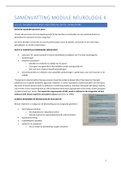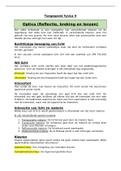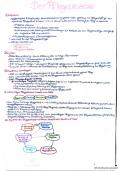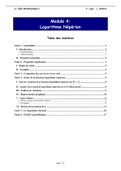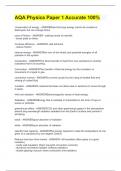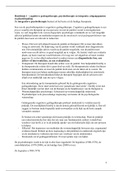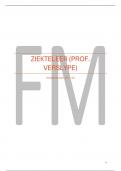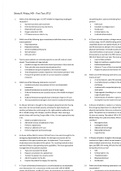OCCUPATIONAL SELF ASSESSMENT (OSA)
What is Occupational Self-Assessment (OSA)?
Self-reported assessment tool
Consists 21 items in which patient rates occupational competence (i.e., how well they
do) and value (i.e., how important it is to them)
Items relate to skills & occupational performance, habitation (incl. habits & roles) and
volition (personal causation, values & interests)
Scoring of occ competence & value on 2 separate 4-point scales
Then combined to form overall score btwn 0-100
o Higher score = higher occupational competence & value
Used to establish priorities and set goals
Part I: Selecting the OSA
How do you work with a model?
When using a model of occupational therapy to organize your practice, should use
the assessments linked to that model.
Finding out the persons’ perspective of their occupational performance, and what
they want to achieve in occupational therapy is essential for client-centered practice.
OSA is a useful tool for assessing individual perspective on occupational
performance
What are the aims of the OSA?
To capture the client’s perception of his/her occupational competence.
To capture the client’s perception of the value of areas of functioning.
To facilitate the client in identifying priorities for change and to participate in
establishing therapy goals and strategies.
To provide the therapist with information about the client’s viewpoint and priorities.
To inform the client of the therapist’s views of his/her adaptation and to establish a
framework for mutual communication and collaboration.
To develop rapport and to promote a sense of partnership between the client and the
therapist.
To provide a measure of the client’s occupational competence and value for
occupation, which can be used to assess client progress and program effectiveness.
To provide a sense of the client’s satisfaction with occupational adaptation.
, What Model of Human Occupation (MOHO) concepts are measured by the OSA?
What is habituation?
o The processes that maintain a pattern in everyday life.
o Two components give regularity to occupational behavior
Internalized roles → reflect position in social environment
e.g., being a parent, worker, friend, and sibling
provide identity and expectations for behavior
Habits → evolve from repeated behavior in particular environment
enable behavior to be automatic and to fit environmental
conditions
e.g., daily routine / manner of doing familiar occupations
What is volition?
o The process by which a person experiences, interprets, anticipates and
chooses occupational behaviors.
o Theorized to be a collection of thoughts and feelings pertaining to:
Abilities and effectiveness
Enjoyment and satisfaction
Important and meaningful
o Made of three components
Personal causation → one’s sense of capacity and efficacy
Interests → what one is attracted to and prefers to do
Values → one’s view of life and of the world.
What is Occupational Self-Assessment (OSA)?
Self-reported assessment tool
Consists 21 items in which patient rates occupational competence (i.e., how well they
do) and value (i.e., how important it is to them)
Items relate to skills & occupational performance, habitation (incl. habits & roles) and
volition (personal causation, values & interests)
Scoring of occ competence & value on 2 separate 4-point scales
Then combined to form overall score btwn 0-100
o Higher score = higher occupational competence & value
Used to establish priorities and set goals
Part I: Selecting the OSA
How do you work with a model?
When using a model of occupational therapy to organize your practice, should use
the assessments linked to that model.
Finding out the persons’ perspective of their occupational performance, and what
they want to achieve in occupational therapy is essential for client-centered practice.
OSA is a useful tool for assessing individual perspective on occupational
performance
What are the aims of the OSA?
To capture the client’s perception of his/her occupational competence.
To capture the client’s perception of the value of areas of functioning.
To facilitate the client in identifying priorities for change and to participate in
establishing therapy goals and strategies.
To provide the therapist with information about the client’s viewpoint and priorities.
To inform the client of the therapist’s views of his/her adaptation and to establish a
framework for mutual communication and collaboration.
To develop rapport and to promote a sense of partnership between the client and the
therapist.
To provide a measure of the client’s occupational competence and value for
occupation, which can be used to assess client progress and program effectiveness.
To provide a sense of the client’s satisfaction with occupational adaptation.
, What Model of Human Occupation (MOHO) concepts are measured by the OSA?
What is habituation?
o The processes that maintain a pattern in everyday life.
o Two components give regularity to occupational behavior
Internalized roles → reflect position in social environment
e.g., being a parent, worker, friend, and sibling
provide identity and expectations for behavior
Habits → evolve from repeated behavior in particular environment
enable behavior to be automatic and to fit environmental
conditions
e.g., daily routine / manner of doing familiar occupations
What is volition?
o The process by which a person experiences, interprets, anticipates and
chooses occupational behaviors.
o Theorized to be a collection of thoughts and feelings pertaining to:
Abilities and effectiveness
Enjoyment and satisfaction
Important and meaningful
o Made of three components
Personal causation → one’s sense of capacity and efficacy
Interests → what one is attracted to and prefers to do
Values → one’s view of life and of the world.

